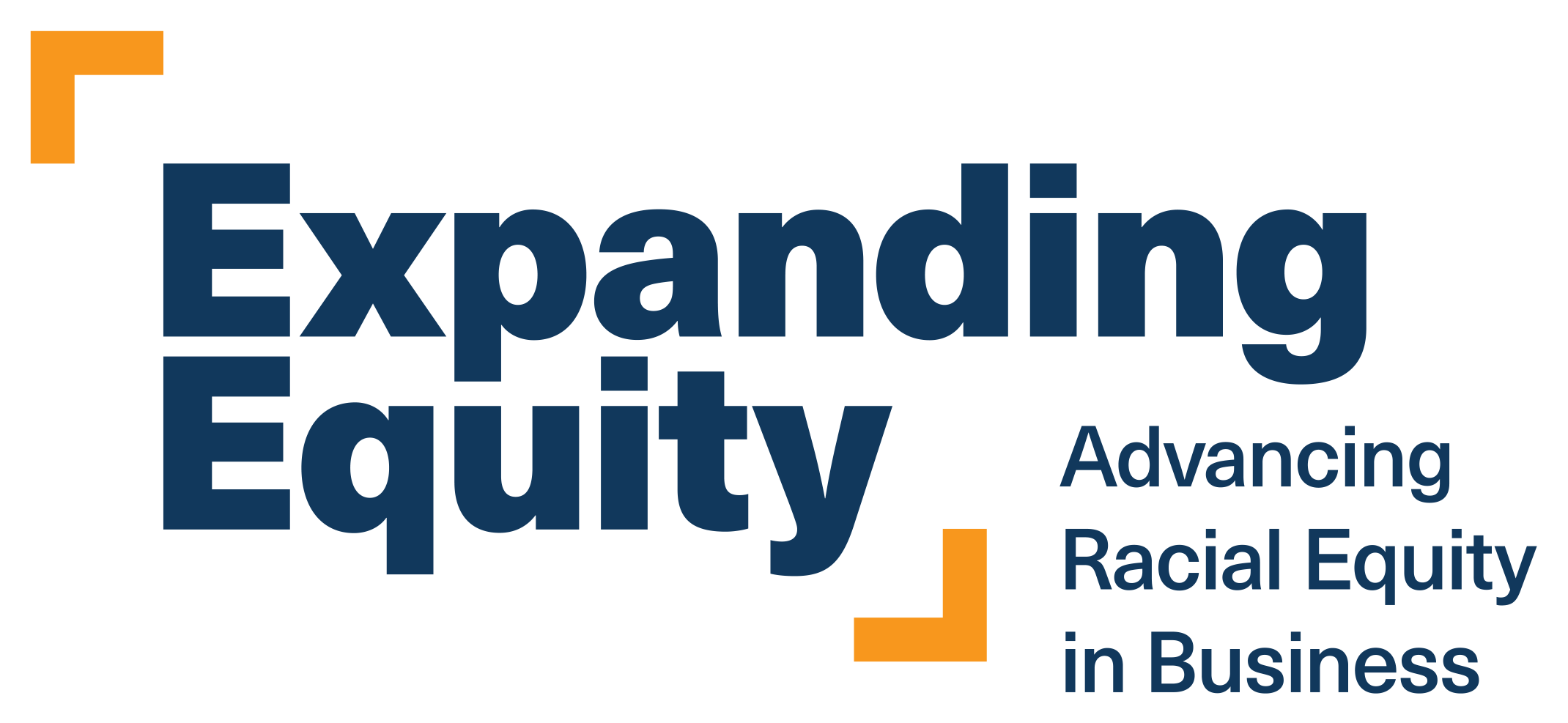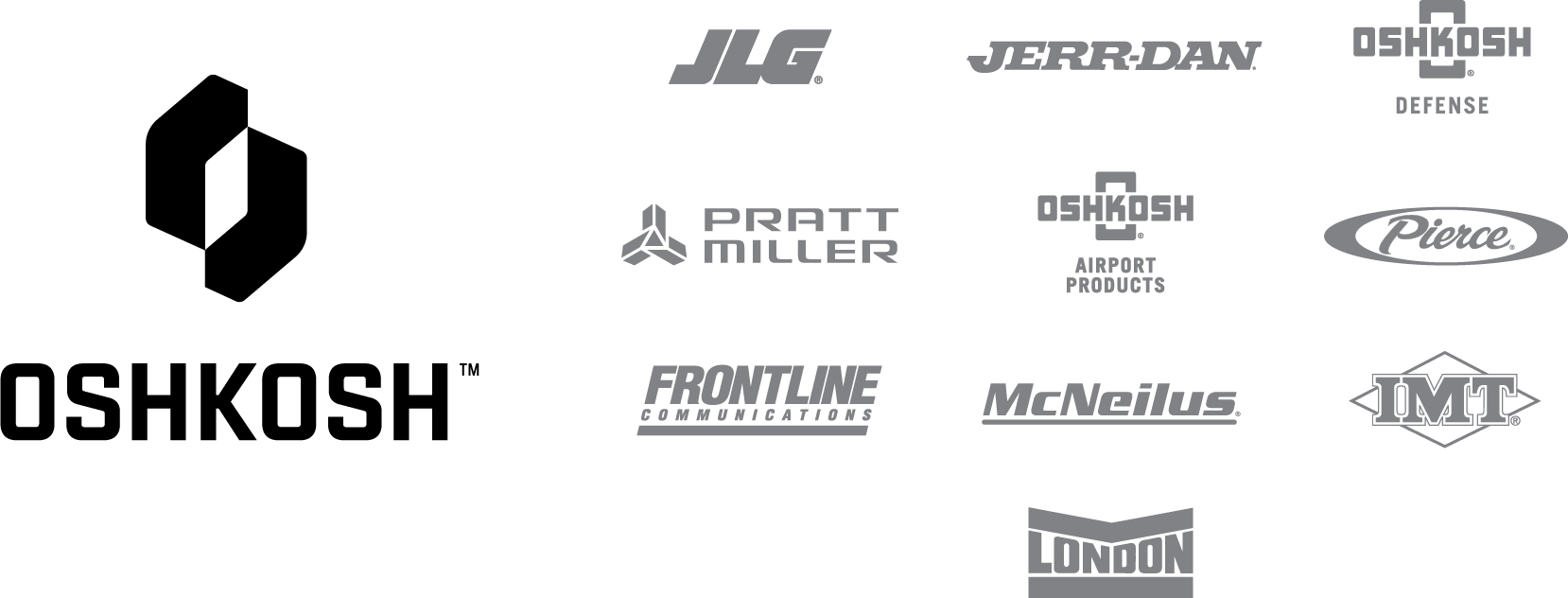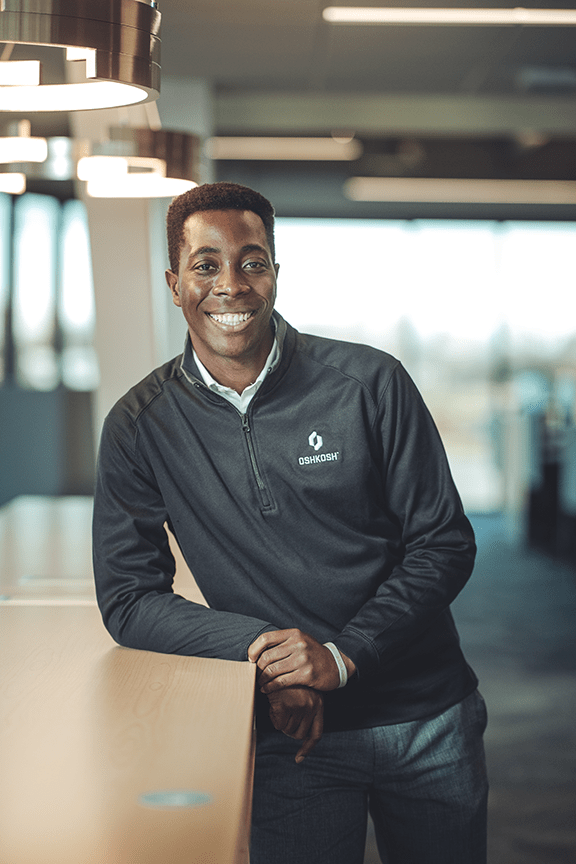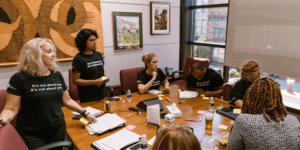Advancing DE&I Representation Goals through Formal Incentives
Oshkosh Corporation Case Study
August 2022

This case study is part of the W.K. Kellogg Foundation’s Expanding Equity program, which helps workplaces become more racially equitable places of opportunity. The program supports and inspires companies to take action using four pillars: Attract, Belong, Promote and Influence. Each pillar offers opportunities for advancing racial equity, diversity and inclusion in companies. This case study lifts up actions from the Attract pillar, which focuses on attracting and hiring professionals of color into a company, in turn increasing representation at all levels of the organization.

Executive Summary
At Oshkosh, their purpose is to make a difference in people’s lives. Because of their People First culture, diversity, equity and inclusion (DE&I) are a priority for the company. They have been on a journey to ensure their team members can bring their full selves to work so they feel valued, respected and included.

Oshkosh has done a number of things to increase diversity representation. One was establishing leadership level goals for global female and U.S. Black, Indigenous and people of color (BIPOC) representation. To achieve these goals, they took the additional step of tying achievement of these goals to the long-term incentive pay for leaders.
"Creating an inclusive, diverse culture is not only the right thing to do, it ensures we continue to be an innovation leader. Setting DE&I expectations with our leaders and tying DE&I goals to their performance pay is one very important step that will nurture and create a diverse and inclusive culture at Oshkosh."
Emma McTague, SVP and chief human resources officer
To implement this, Oshkosh took the following actions:
- Researched different data points and benchmarks and set one of their racial equity aspirations: to be an organization with the best talent that reflects broader market demographics
- Took their research and collaborated with their Total Rewards and Finance teams to link DE&I representation goals to leader compensation
- Established their DE&I representation goals and milestones and tied them to a formal incentive plan
- Mobilized their employees to act by using multiple channels (e.g., key leadership meetings, internal DE&I newsletter) to build awareness of these changes
To sustain these efforts, Oshkosh’s top leaders meet on a quarterly basis to discuss key business initiatives, including talent initiatives such as these DE&I goals. Along their journey, Oshkosh took away several key learnings to share with other companies looking to implement a similar initiative:
- Take time to build relationships and learn about the company culture before making changes and setting goals
- Tie DE&I goals to the company’s overall strategy to provide greater clarity to the rest of the organization about the business impact of these goals
- Never build in a vacuum and constantly collaborate with others
"We know that in order for us to innovate and continue to be the leader that we are, diversity and inclusion are critical."
The Challenge
Their objective was bold — while a lot of companies set DE&I representation goals to create alignment and encourage leadership commitment to achieving them, Oshkosh Corporation wanted to take it a step further in 2021 and tie these goals to the long-term performance pay of their leaders.
“We know in order for us to innovate and continue to be the leader that we are, diversity and inclusion are critical,” said Jill Hanegraaf, the senior marketing manager of global branding and communications at Oshkosh.
By tying their DE&I representation goals to pay incentives, Oshkosh demonstrated that their DE&I representation goals are just as important as other business priorities.
“We wanted to treat DE&I goals the same as any other business goals and to include how we reward our leaders for achieving results and making change,” explained Darcy Pierson, the global director of diversity & inclusion at Oshkosh. “Embedding [these goals] within the day-to-day operations and behaviors of our teams will enable us to have greater success.”
A year after Oshkosh implemented this initiative, we asked Pierson and the Oshkosh team to share the steps they took and advice they have for other companies looking to embark on a similar journey.

Background
Innovation and the commitment to making a difference in people’s lives have always been a core part of Oshkosh Corporation. Oshkosh is a manufacturing company and more importantly, they are an industrial technology company founded more than 100 years ago.
They make innovative, mission-critical equipment to help everyday heroes advance communities around the world. They are a leading designer and global manufacturer of access equipment, specialty vehicles and truck bodies across 10 businesses with facilities in 24 countries. Even though the company has grown to more than 15,000 employees, Oshkosh remains committed to their purpose of making a difference in people’s lives and created a company culture that emphasizes putting people first, doing the right thing, and being better together.
Oshkosh firmly believes that “we are better together” if the company has a diverse group of employees and the best talent that reflects the broader market demographics because that drives innovation. They set DE&I representation goals for the officer level and above at their company and tied them to the long-term performance pay of their officers to show just how important these goals are in relationship to other organizational priorities.
Journey of setting DE&I goals and tying to leader compensation
As a starting point, Oshkosh took a robust look at (1) their internal company data and model of opportunity, (2) external stakeholder trends and benchmarks and (3) the DE&I goals of their industry peers and (4) the DE&I goals of the companies where their board members currently work at or serve.
Understanding their internal company data and building the model of opportunity
Oshkosh looked at their internal representation metrics to gain a better understanding of current representation in detail. Example metrics included their hiring rates, promotion rates and retirement data. They analyzed questions such as, “Is Oshkosh hiring more men vs. women?” and “How many employees will retire over the course of the next five years?”
Then, Oshkosh used a five-year look-back and look-forward model to predict what the opportunity would look like if their company increased diversity across the organization at all levels. This gave them further insight on what their DE&I representation goals should be.
Reviewed external stakeholder trends and benchmarks
Oshkosh found it helpful to look at external trends from relevant indexes and public data to benchmark against their own internal representation metrics. For example, they looked at the Paradigm for Parity, an external benchmark focused on advancing women in business, and other public demographic data, such as the Bureau of Labor Statistics for Industrial Manufacturers.
Benchmarked against their peers
Oshkosh defined their industry peers as the companies included in the earnings reports compiled by their chief financial officer. “We went to [our peers’] websites to find public documents, such as investor communications, and reviewed their information,” explained Pierson.
“We asked ourselves questions, such as ‘did the company state a public DE&I goal?’ and ‘has the company publicly shared what their representation looks like from a diversity lens?,’” said Pierson. Then Oshkosh created a table to better understand how they compare to their peers.
Reviewed the DE&I goals of the companies that their board members work at or currently serve
Recognizing the influence that board members have over the direction of the company, Pierson and her team wanted to know what was happening within the organizations that Oshkosh’s board members work at or serve.
They identified all the companies that their board members were associated with and researched how far along those companies were in their DE&I journey. This helped Oshkosh better understand how their board members experience and think about DE&I.
Oshkosh had been on a DE&I journey for a few years and wanted to strengthen their commitment to making progress on talent representation. Oshkosh knew that many industrial manufacturers are slow to make progress on Environmental, Social and Governance (ESG) initiatives and wanted to become an industry leader in this space.
After reviewing their DE&I starting point, Oshkosh set one of their racial equity aspirations to be an organization with the best talent that reflects broader market demographics.
Oshkosh demonstrated to their leadership that the business case for DE&I aligns to the company’s strategy and purpose. Pierson explained, “we synthesized the proven body of research that ‘organizations that are more diverse outperform their peers from a talent, financial and innovation perspective’ and aligned it to our company’s strategy.”
Starting with a business case and aligning it to Oshkosh’s strategy and purpose helped provide greater clarity to their leadership about the business impact that diversity would have on their organization. It also helped leaders understand the importance of setting DE&I goals and start thinking about the ways they could contribute toward them.
Then Oshkosh took all the information they had researched and collaborated with their Total Rewards and Finance teams to link DE&I representation goals to leader compensation. The Total Rewards team played a key role in this effort because of the team’s influence on pay equity, benefits and other team member rewards.
Another key stakeholder in this process was Oshkosh’s Talent Acquisition team. The team helps build Oshkosh’s brand, deepen relationships with diverse organizations and generate diverse talent pools that will lead to more diverse hiring. To broaden the talent pool, Oshkosh’s talent acquisition team has been strategically partnering with different organizations, such as RippleMatch, DOD Skillbridge, Hiring Our Heroes, HBCUs, Black Progress Matters and Society of Women Engineers.
Oshkosh decided to tie the goals to the long-term performance pay of officers because the company believes that if they bring in diverse leaders, diverse talent will follow. Also, officers are often the ones who are hiring at the director level and above, and Oshkosh wanted to give officers more autonomy and connection over who they are hiring.
Oshkosh established goals and milestones for achieving global female representation and U.S. Black, Indigenous and people of color (BIPOC) representation among director-level and above positions, tying them to a formal incentive plan.
The DE&I representation goals are aggressive because Oshkosh believes that ambitious goals paired with milestones will encourage movement and leadership among their officers and VPs. In their case, the milestones connect to an executive long-term incentive plan with three payout levels based on achievements set over a three-year rolling cycle.
Then, Oshkosh mobilized their employees to act by using multiple channels. The company started by having the key sponsors of this initiative — their CEO, John C. Pfeifer, and CHRO, Emma M. McTague — talk at their key leadership meetings and explain the why of the initiative. Then, Oshkosh utilized their internal DE&I newsletter, sent to all office members, to build awareness across the company and encourage staff to hold each other accountable.
To track progress over time, quarterly management reports are sent to Oshkosh’s leadership team (i.e., CEO John C. Pfeifer and his direct reports) and respective HR leadership. Oshkosh will disclose representation metrics publicly on an annual basis on their website and Sustainability Report with broader public disclosures as the initiative matures.
As of 2021 year-end, Oshkosh had 18.3% of women in leadership roles globally and 8.6% of Black, Indigenous and/or People of Color in U.S. leadership roles. The company plans to provide an update on these representation metrics in 2023.
Oshkosh is also working on implementing other tools to strengthen their employees’ leadership skills around the topic of inclusion. These tools will teach their employees how to communicate across differences and reduce unconscious bias in decision-making.
To sustain these efforts, Oshkosh brings their top leaders together on a quarterly basis to discuss key business initiatives, including DE&I talent initiatives. Since Oshkosh implements their DE&I strategy through their business segments, the central DE&I team is supporting their leadership teams at the local level through continued coaching, education and efforts to share best practices so that these teams can be successful.
How the Expanding Equity program supported Oshkosh
The Expanding Equity program offers every company an analysis of their current talent pipeline and the diversity representation at each job level. Oshkosh found that the analysis gave an outside-in view that added another layer of credibility that the DE&I team could bring back to their human resources leaders.
“The outside view of [the talent pipeline] has been very powerful. That’s definitely been something that [we’ve used] to facilitate some of our internal discussions,” explained Amanda Mickelson, senior human resources director of employee experience and talent.
“It was probably a bit of an ‘aha’ moment from a DE&I perspective to say:, 'While we have some things we are going to try to drive from the center, we really need each of our own segments to take charge and own their diversity journey.’ I really do think the Expanding Equity program was critical in that mindset shift for us."
Amanda Mickelson, senior human resources director of employee experience and talent
Another helpful support was a discussion about effective DE&I governance for companies that need to balance advancing a central DE&I strategy while equipping segments of their company to own a part of that strategy. Oshkosh has four segments and 10 companies under their umbrella, and each segment operates differently, so the DE&I team had to support strategy implementation across and within each brand.
“It was probably a bit of an ‘aha’ moment from a DE&I perspective to say:, “While we have some things we are going to try to drive from the center, we really need each of our own segments to take charge and own their diversity journey.’ I really do think the Expanding Equity program was critical in that mindset shift for us,” said Mickelson.
By inviting representatives from each segment to participate in the Expanding Equity program, each segment was able to define how they wanted to advance the company’s DE&I goals. “We are creating the framework, and, in this case, our DE&I goals and aspirations are part of that framework … but how [each segment] puts it together locally is where they have that flexibility and ownership” explained Pierson.
Each segment embeds relevant DE&I goals into their strategic plans by including those goals when conducting critical role and talent assessments and retention risk assessments, including risk mitigation planning and driving succession planning for critical leadership positions. These strategic plans then roll up to the collective company, and the central DE&I team monitors, discusses, provides reporting, and reviews progress on a quarterly basis.
Oshkosh also gives each segment the chance to share what they are doing and discuss best practices during their quarterly DE&I council meetings. The central DE&I team creates scorecards so they can deliver metrics to each segment on a regular basis to invoke conversation as well. “We are still learning, but it truly is, community as a practice” says Pierson.

Results/Progress-to-date
The company has seen progress in both retention and representation aligned with their goals for both gender and BIPOC representation. WKKF will update this case study next year with Oshkosh’s latest representation metrics after Oshkosh publicly discloses them at year-end, but so far this year, Oshkosh is seeing improvement in their overall diversity metrics.
Results are shared on a quarterly basis in leadership meetings by Oshkosh’s CHRO. Oshkosh publishes a diversity representation dashboard and a movement report and sends to their executive leaders every quarter. The dashboard incorporates detailed data about Oshkosh’s activity (e.g., representation, turnover, promotions, transfers) at senior levels in the company. “The level of transparency and analytics that we are providing to leadership about our progress is something Oshkosh has not historically ever seen,” explained Pierson, “this has allowed [leaders] to use the data more across our business to drive more action.”
Key Learnings
The Oshkosh DE&I team offers the following wisdom from their journey:
1. Take time to build relationships and learn about the company culture before making changes and setting goals
Pierson emphasized that having solid relationships with other teams helped her when it came time to implementing changes. When she joined in 2018, Oshkosh gave her the time to learn about the company culture and connect with others before taking action. She explained, “I don’t think without that foundation, we would be where we are today. We would not be as ready as an industrial manufacturer to take internal and external action.”
Hanegraaf agreed, “Yes, you need to have buy-in from the top, but you also need to [build relationships] and that is key to being able to drive and move forward.”
2. Tie DE&I goals to the company’s overall strategy to provide greater clarity to the rest of the organization about the business impact of these goals
When a new CEO joined Oshkosh in 2021, the company refreshed their strategy to the themes of “Innovate, Serve and Advance.” The central DE&I team intentionally tied DE&I into the “Innovate” part of the company strategy to ensure that it is not off on its own silo or by itself to make it more sustainable and better understood within the organization.
Hanegraaf explained that they chose the “Innovate” part of the company strategy because, “diversity of everything is critical to delivering our strategic goals under the serve and advance pillars of our corporate strategy.”
3. Never build in a vacuum and constantly collaborate with others
Pierson and her team partnered closely with the compensation committee of the board when they were exploring the idea of tying compensation to DE&I representation goals. Since they engaged the right stakeholders early on, they were able to incorporate a lot of these key stakeholders’ thoughts into the plan. Then when it came time to approve the final plan, they were able to get approval quicker because those stakeholders had buy-in early in the process.
Suggested Resources
Explore More Expanding Equity Content

Linking ideas, tools and knowledge to action

DEI expert: Be proactive, not reactive

Implementing HR policies and practices that center and advance racial equity, diversity and inclusion: New toolkit shares WKKF’s “how”
Diversifying suppliers, vendors and business partners as part of DEI strategy

Actions for racial equity in the investment management industry

Using a skills-based hiring approach as part of a DEI strategy

DEI and the frontline worker experience

Ripples of Change: Ralph de Chabert’s racial equity, diversity and inclusion journey

Inclusion & Belonging: Actions toward racial equity



Comments